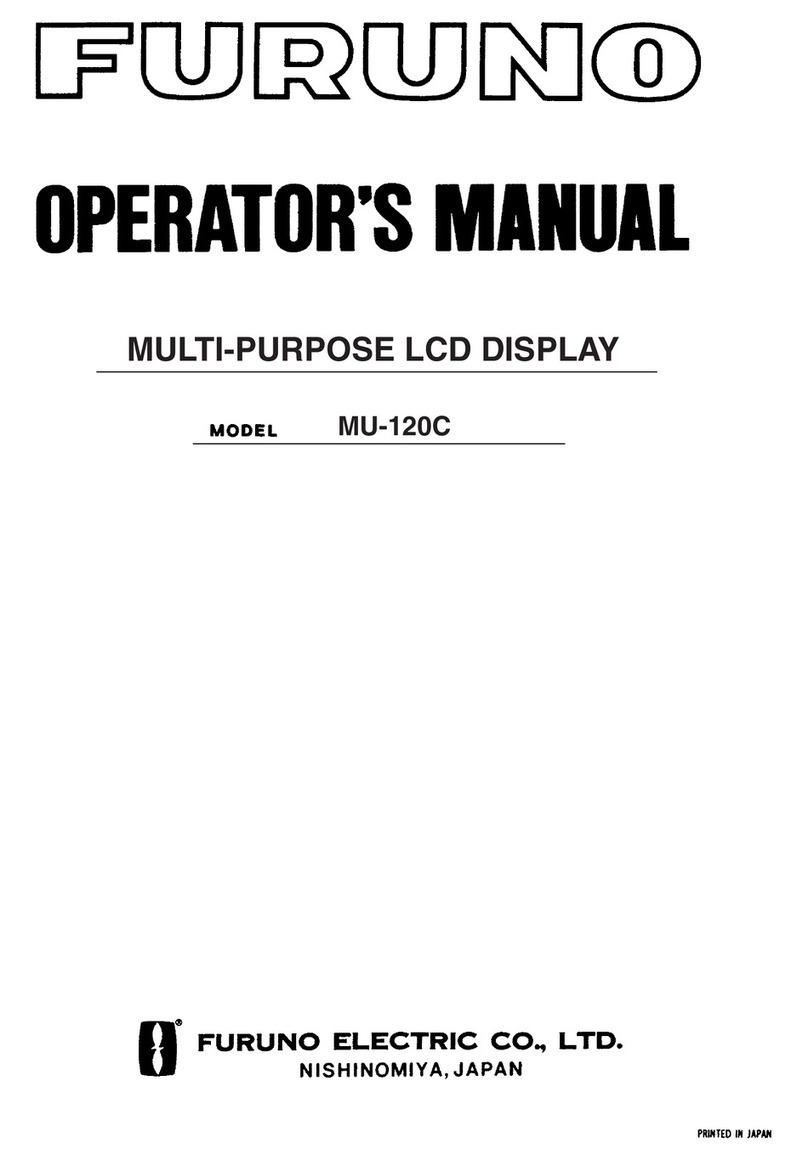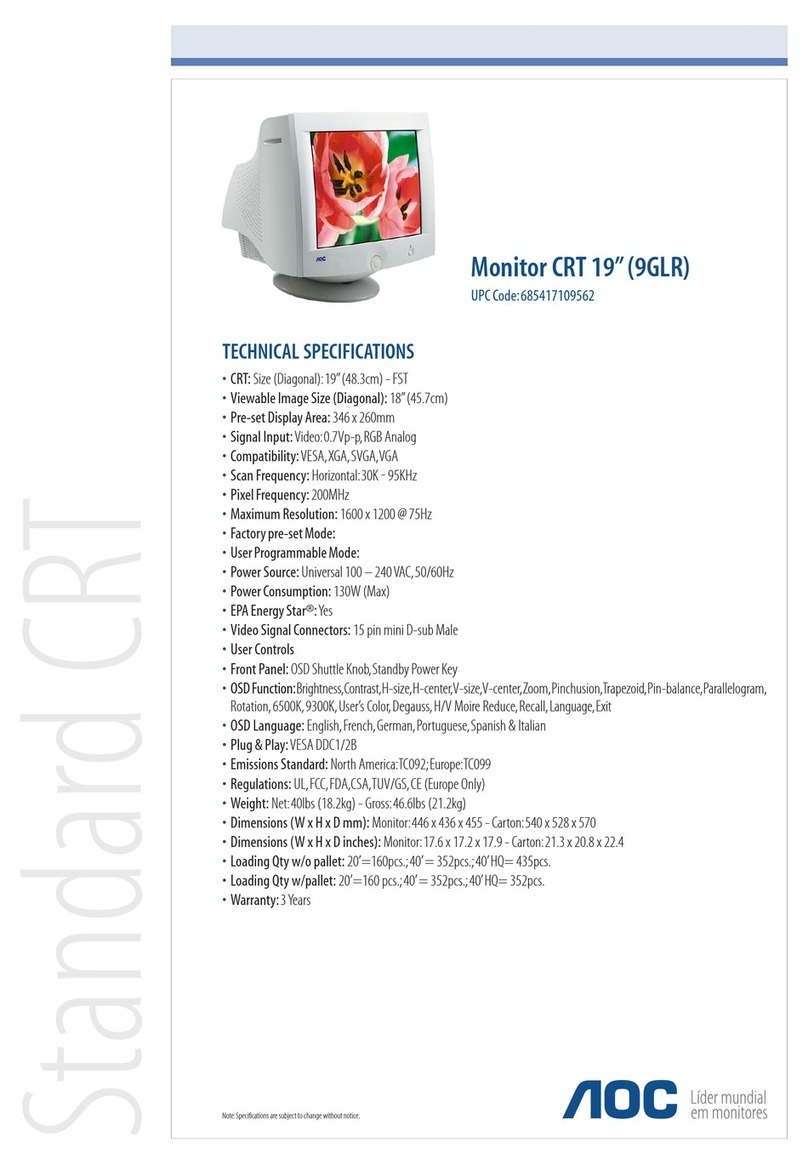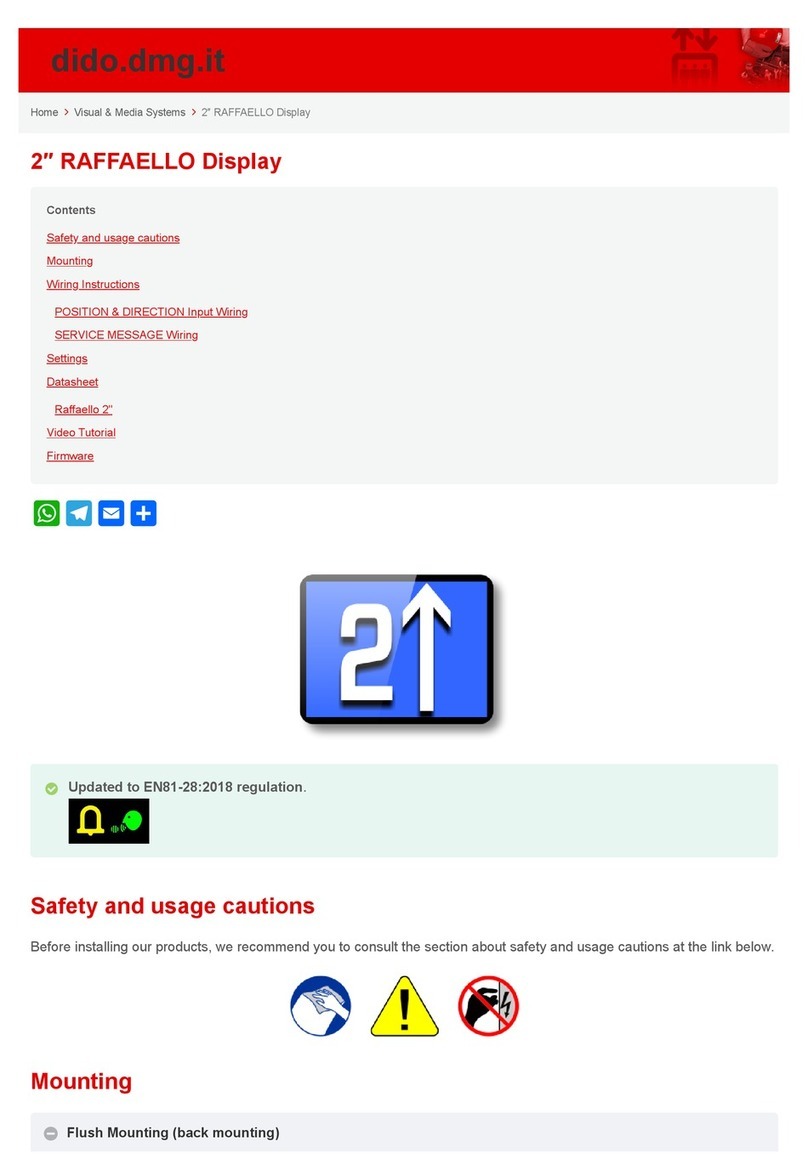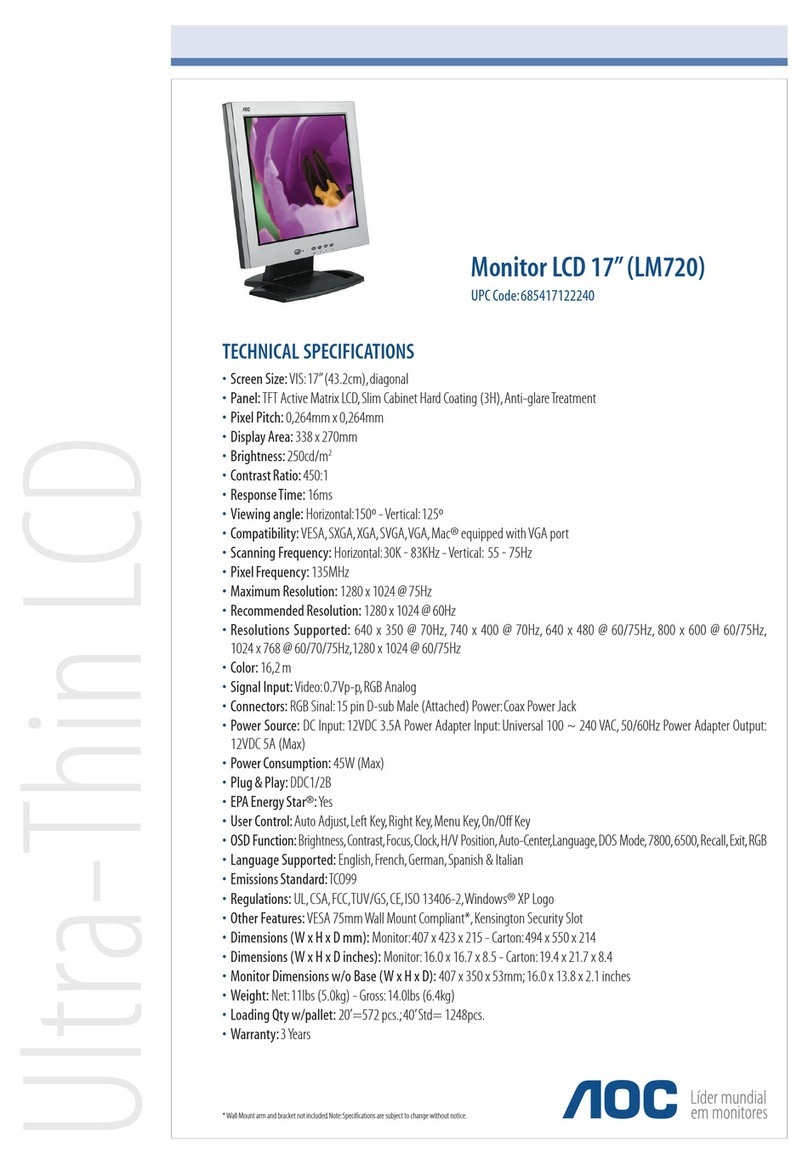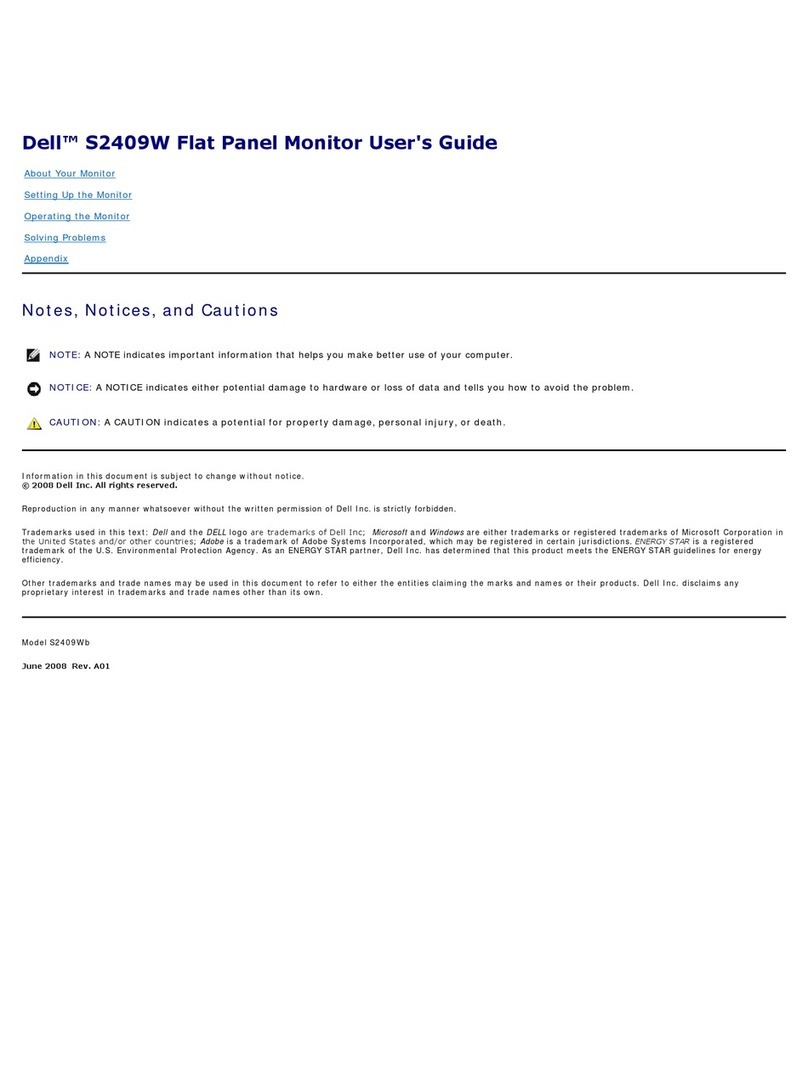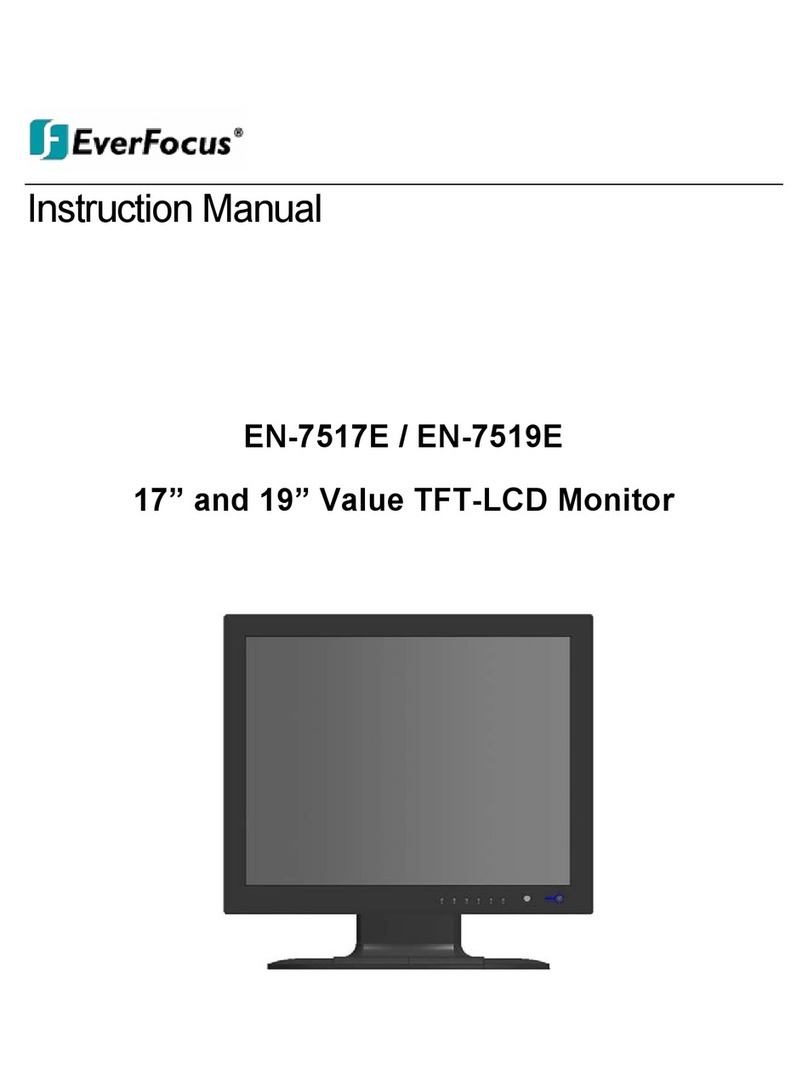Armstrong Monitoring Corporation 1AVC User manual

Gas Monitor
1AVC
Two Channel Monitor
INSTRUCTIONS
Installation and Operation of the
Gas Monitor 1AVC Two Channel Monitor
IMPORTANT:
Please read these installation and operating instructions completely
and carefully before starting.
Filename: 3216405A.doc
Copyright © July 2009, AMC
The Armstrong Monitoring Corporation
215 Colonnade Road South, Ottawa, Ontario, Canada K2E 7K3
Tel: (613) 225-9531 • Fax: (613) 225-6965 • Canada & U.S. Toll Free: 1-800-465-5777


Gas Monitor 1AVC Two Channel Monitor
1
TABLE OF CONTENTS
Section Title Page
1WARRANTY..........................................................................................................................3
1.1 LIABILITY .......................................................................................................................3
1.2 PRODUCT RETURN......................................................................................................3
1.3 MODIFICATIONS AND SUBSTITUTIONS.....................................................................3
2PRODUCT INFORMATION...................................................................................................4
3PRODUCT DESCRIPTION ...................................................................................................5
3.1 GENERAL DESCRIPTION.............................................................................................5
3.1.1 MONITOR FEATURES ...........................................................................................5
4INSTALLATION ....................................................................................................................8
4.1 MOUNTING INSTRUCTIONS ........................................................................................8
4.2 WIRING ..........................................................................................................................9
4.2.1 MONITOR WIRING .................................................................................................9
4.2.2 GAS MONITOR INTERFACE CONFIGURATION ................................................10
4.2.2.1 On-Board Sensors Connection ......................................................................11
4.2.2.2 Building Automation Wiring ............................................................................12
4.3 DIP SWITCH PROGRAMMING ...................................................................................13
4.4 ALARM RELAY PROGRAMMING ...............................................................................15
4.5 AUDIO ALARMS ..........................................................................................................16
5OPERATION AND CALIBRATION.....................................................................................17
5.1 POWER-ON DELAY.....................................................................................................17
5.2 TEST SWITCH FUNCTION..........................................................................................17
5.3 ACKNOWLEDGE FUNCTION......................................................................................17
5.4 ALARM/WARNING RELAY ACTIVATION DELAYS ....................................................17
5.5 RELAY OUTPUTS........................................................................................................17
5.6 CALIBRATION/SERVICE.............................................................................................18
5.6.1 TRIP THRESHOLD ADJUSTMENT......................................................................18
5.6.1.1 Equipment Required ......................................................................................19
5.6.1.2 Trip Threshold Adjustment .............................................................................19
5.6.2 AMC-DSI CALIBRATION ......................................................................................20
5.6.2.1 On Site Calibration Equipment Required .......................................................20
5.6.2.2 Calibration Procedure ....................................................................................20
5.6.2.3 Recalibration ..................................................................................................22
6PREVENTIVE MAINTENANCE ..........................................................................................23
6.1 GENERAL ....................................................................................................................23
6.2 VERIFICATION OF OPERATION ................................................................................23
6.3 SENSOR REPLACEMENT ..........................................................................................23
7INSTALLATION TIPS AND TRICKS ..................................................................................24

Gas Monitor 1AVC Two Channel Monitor
2

Gas Monitor 1AVC Two Channel Monitor
3
1WARRANTY
The AMC-1AVC two-channel monitor is warranted against defects in material and workmanship
for a period of two (2) years from date of shipment (except electrochemical sensor elements,
catalytic elements and portable monitors – one (1) year – refer to individual spec sheets for
additional exceptions). Calibration is not warranted. During the warranty period, Armstrong
will repair or replace components that prove to be defective in the opinion of Armstrong
Monitoring. The corporation is not liable for auxiliary interfaced equipment, nor consequential
damage.
NOTE: Any substitution or tampering with components without expressed, written permission of
ARMSTRONG MONITORING may result in intrinsic damage which will cancel the effectiveness
of the warranty. Extended warranties are available through the factory. Please contact factory.
Service agreements may supersede standard warranty terms.
1.1 LIABILITY
All Armstrong Monitoring systems shall be installed by a qualified technician and maintained
according to Armstrong Monitoring Installation and Maintenance Manual instructions.
Armstrong Monitoring shall not be responsible for any liability arising from auxiliary interfaced
equipment, consequential damage, the installation, or the operation of this equipment.
Armstrong’s total liability is contained in the warranty conditions stipulated above. No other
acceptance of liability is expressed or implied by Armstrong Monitoring. Except as set forth
herein, Armstrong Monitoring makes no warranty, expressed or implied, with respect to the
fitness for any particular purpose or use or otherwise of the products or services, or on any parts
or components or labour furnished as part of the sale. In no event shall Armstrong Monitoring,
its officers, directors, employees, agents or servants be liable to the buyer or any other party for
any loss of profit, loss of use, incidental, consequential or special damages arising out of the
sale, delivery, servicing, use, loss of use, of the products or of any part thereof, irrespective of
whether Armstrong Monitoring or any of its officers, directors, employees, agents or servants
has advanced notice of the possibility of such damages. In no event will the total liability to the
buyer exceed the sum paid to Armstrong Monitoring by buyer for the products and services.
1.2 PRODUCT RETURN
All products that must be returned for warranty service will be shipped by prepaid freight and will
only be accepted with a Returned Materials Authorization (RMA) number issued by
ARMSTRONG MONITORING. Goods returned to the client will be by freight collect.
1.3 MODIFICATIONS AND SUBSTITUTIONS
Due to an ongoing development program, Armstrong Monitoring reserves the right to modify the
design and substitute components in any of its products without prior notice. All changes are at
the sole discretion of Armstrong Monitoring, and the corporation shall not be liable for any cost
arising out of such modifications or substitutions that may be incurred by the user.

Gas Monitor 1AVC Two Channel Monitor
4
2PRODUCT INFORMATION
Monitor Part Number….…………………………………. AMC-1AVC
Monitor Serial Number. ………………..………………...
DSI Part Number…………………………………………. AMC-DSI-91AD-98AA-X
DSI Serial Number. ………………..……………….........
DSI Warranty Period……………………………………... 2 year
Sensor Warranty Period…………………………………. CO Channel 1 __________________
NO2Channel 2 _________________
Power Supply Requirement. ………………….……..…. 120 VAC, 60 Hz, 30 VA
Operating Temperature.…….………………….……..… -20°C to +40°C (-4°F to +104°F)
Operating Pressure..…………….…………….……..….. Ambient atmospheric pressure
Relative Humidity..…………….…………….……..…….. 35 – 85% non-condensing.
Alarm Trip Points
Signal Input
Configuration Part No. Serial No. Type of Gas Warning Alarm
Full
Scale
DSI Channel 1 CO
DSI Channel 2 NO2
TORQUE SPECIFICATIONS:
POWER SUPPLY:
Neutral terminal screw ……………………………………………………………… 7 pound-inches.
Hot terminal screw …………………………………………………………...……... 7 pound-inches.
Ground Lug screw. …………………………………………………………………. 15 pound-inches.
RELAY:
Relay socket terminal screws ……………………………………………………… 7 pound-inches.
Note:
All Armstrong Monitoring systems must be installed and maintained according to
instructions, to ensure proper operation. Only qualified technicians should install and
maintain the equipment.

Gas Monitor 1AVC Two Channel Monitor
5
3PRODUCT DESCRIPTION
3.1 GENERAL DESCRIPTION
The Gas Monitor 1AVC is a two channel gas monitoring system incorporating state of the art
sensing technology using micro-controller based design to provide continuous, reliable
surveillance of surrounding air for traces of hazardous gases (listed in Section 2). The DSI (Dual
Sensor Interface) permits two on-board sensor inputs and two 4-20 mA signals out. The monitor
comes with the following features, see Figures 1 and 2.
3.1.1 MONITOR FEATURES
1. RUN/FAULT/OFF INDICATOR: A green LED for each channel.
RUN: LED on
FAULT: LED flashing
OFF: LED off
2. WARNING INDICATOR: Warning levels of gas are indicated by a yellow LED for
each channel. Warning concentrations are indicated in
Section 2
3. ALARM INDICATOR: Alarm levels of gas are indicated by a red LED for each
channel. Alarm concentrations are indicated in Section 2
4. POWER TERMINAL BLOCK: For line voltage connections of 120 VAC, 60 Hz
5. TRANSFORMER: A Class II, step down transformer powers the internal
circuitry and remote sensor at low voltages. Located
underneath the PCB
6. INTERNAL WIRING HEADER: Provides wiring connection points as follows:
1,2,3 - Relay coils
4,5,6,7,8 - Reserved
9,10 - Acknowledge switch
11,12 - Audio alarm indicator
7. AUDIO ALARM INDICATOR: The buzzer will activate for Alarm, Warning
(configurable) and Fault conditions, with a distinct tone
for each one
8. RELAY SETUP JUMPERS: Used to independently configure the Warning and Alarm
relays as Normally Energized or Non-Energized
9. TEST SWITCH: The test switch is provided to electronically simulate
alarms in order to test audio and relay functions
10. CHANNEL 1 ADJUSTMENT: Sets the Alarm and Warning for channel 1

Gas Monitor 1AVC Two Channel Monitor
6
11. CHANNEL 2 ADJUSTMENT: Sets the Alarm and Warning for channel 2
12. PROGRAMMING DIP
SWITCHES:
Allows user to configure the alarm delay and timer
circuits, audio alarm activation, sensor mode selection,
fault threshold, and acknowledge switch function
13. RELAYS: 2 alarm DPDT relays are provided
14. DSI (Dual Sensor Interface): Dual sensor interface: allows two on board sensors and
a 4-20mA signal out
15. ON-BOARD SENSORS: Sensors allows local detection of gas
16. SIGNAL INPUT/OUTPUT
TERMINAL BLOCK:
Allows connection to transmitter input and output
Channel 1: Pins 1-6
Channel 2: Pins 7-12
1, 7 - Negative
2, 8 - 4-20mA out
3, 9 - Power
4, 10 - 4-20mA in
5, 11 - Chassis ground
6, 12 - Signal ground
1. RUN/FAULT/OFF
2. WARNING
3. ALARM INDICATOR
INDICATOR
INDICATOR
FIGURE 1: Gas Monitor 1AVC, Front Cover.

Gas Monitor 1AVC Two Channel Monitor
7
FIGURE 2: Internal Features of the Gas Monitor 1AVC.

Gas Monitor 1AVC Two Channel Monitor
8
4INSTALLATION
Follow the guidelines in this section for proper locations and installation of the Gas Monitor
1AVC. In addition to these instructions, ensure installation is compliant with local building and
electrical codes. This section covers topics related to installation location, mounting, cable
selection, wiring instructions and monitor function programming for the Gas Monitor 1AVC.
4.1 MOUNTING INSTRUCTIONS
Securely fasten the Gas Monitor 1AVC unit on a solid, non-vibrating surface or structure. Install
the unit where it is not exposed to rain or water spray. Install in an area where the local
concentration of gas is unaffected by the presence of ventilation systems and away from
sources of interference gases. Mount the monitor where the unit can be observed periodically.
For most applications the monitor should be mounted 1.2 -1.8 m (4-6 ft) from the floor. See
Figure 3 for mounting hole locations.
CAUTION: All cable entry MUST BE through the BOTTOM of the monitor enclosure only.
Other entry locations will allow foreign materials to enter the enclosure, causing possible
damage to the internal components.
4 HOLES
(8.875")
(5.500")
(Ø0.375")
225 mm
140 mm
Ø9.5 mm
FIGURE 3: Locations of Mounting Holes.

Gas Monitor 1AVC Two Channel Monitor
9
4.2 WIRING
4.2.1 MONITOR WIRING
POWER SUPPLY: The monitor operates on 120 VAC, 60 Hz. A Class II step down
transformer runs the internal circuitry at low voltages. The power
supply connections are made at the power terminal block located
inside the monitor, see Figure 4.
RELAYS: The 2 “Ice Cube” DPDT relays are set for different alarm conditions;
one ALARM and one WARNING. The contacts are rated for
10Amps@250VAC resistive. For relay contact arrangement, see
Figure 5.
The Gas Monitor 1AVC is shipped with 2 relays factory configured to be de-energized in the
non-alarm state. If the user prefers to have relays in a normally energized (failsafe) state see
section 4.4 for jumper configuration.
All programmable settings are factory configured for use with sensor options provided on
original order. Certain user options however may be set according to preferences in the field. Be
certain to observe appropriate interconnection of sensors to specified monitor inputs (see
Section 2).

Gas Monitor 1AVC Two Channel Monitor
10
FIGURE 4: Location of Power Supply Connections.
FIGURE 5: Relay Contact Arrangement for 2 or 3 Relays.
4.2.2 GAS MONITOR INTERFACE CONFIGURATION
The AMC-1AVC is factory configured to the following setting.
The input interface is configured by strapping the jumpers shown in Figure 6; note V+ equals
18-22 volts.
Table 1: Signal input configuration jumper selection
SENSOR 1 SENSOR 2
SIGNAL INPUT
CONFIGURATION JB 8
TERMINATION
JB10
POWER SUPPLY
JB7
TERMINATION
JB9
POWER SUPPLY
DSI 4-20 mA V+ 4-20 mA V+
Note:
The signal input configuration jumpers are under the DSI board. Turn off the main
power supply of the monitor before removing the DSI board to configure the jumpers.

Gas Monitor 1AVC Two Channel Monitor
11
JB8
JB10
JB7
JB9
MD-V
SS 4-20mA
V+ +5V
SENSOR 1
SENSOR 2
MD-V
SS 4-20mA
V+ +5V
EXAMPLE
JB8 JB10
SS =
MD-V =
4-20mA =
V+ =
+5V =
NOTE: THE DSI BOARD IS REMOVED
FIGURE 6: Gas Monitor signal input configuration jumpers.
4.2.2.1 On-Board Sensors Connection
Most sensors have a socket connection to the DSI board for easy sensor replacement in the
field while others are directly soldered. For removal, unplug the sensor from the DSI when the
main power supply is turned off. For installation hold the sensor in such a way that the sensing
area is not covered. Align the sensor pins with pin sockets on the DSI and lightly push the
sensor on to the DSI. Sensors need to be calibrated at regular intervals, see 5.6.2 AMC-DSI
CALIBRATION for procedure. Sensor replacement is needed when the sensor life has expired;
see 6.3 SENSOR REPLACEMENT for details.
CAUTION
TURN OFF THE MAIN POWER SUPPLY BEFORE REMOVING THE SENSORS AND HAVE THE
POWER OFF WHEN INSTALLING AS WELL.

Gas Monitor 1AVC Two Channel Monitor
12
4.2.2.2 Building Automation Wiring
On the DSI board, only the 4-20mA output portion of the signal input/output terminal block (see
Figure 2, item 16), is available if there are on board sensors. This output can be connected to
the building automation system. Figure 7 show a detailed depiction of the signal input/output
terminal block.
1
2
3
4
5
6
7
8
9
10
11
12
24681012
1357911
CHANNEL 1 CHANNEL 2
PINS DESCRIPTION
CHANNEL 1 CHANNEL 2
CH 1 CH 2
1
2
3
4
5
6
7
8
9
10
11
12
NEGATIVE
4-20mA SIGNAL OUTPUT
4-20mA SIGNAL INPUT
POSITIVE
CHASSIS GROUND
SIGNAL GROUND
TOP VIEW
FRONT VIEW
SYMBOL
CGND
4-20mA
OUT
4-20mA
IN
FIGURE 7: Signal input/output terminal block.
Note:
Use Copper Conductors Only.
The building automation system is wired to the Gas Monitor through the signal input/output
terminal block on the DSI board. The wiring for channel 1 and 2 are conveyed in the following
table.
Gas Monitor Building Automation System
Negative - →Not applicable
4-20mA signal output 4-20mA
out →4-20mA signal input
Positive + →Not applicable
4-20mA signal input 4-20mA
in →Not applicable
Chassis ground CGND →Connect to shield of cable
Signal ground - →Negative -

Gas Monitor 1AVC Two Channel Monitor
13
EXAMPLE OF CHANNEL
1 CONNECTION EXAMPLE OF CHANNEL
2 CONNECTION
1
2
3
4
5
6
7
8
9
10
11
12
CHANNEL 1 CHANNEL 2
CGND CGND
4-20mA
OUT IN
4-20mA4-20mA
OUT IN
4-20mA
CHANNEL 1 CHANNEL 2
SENSE RESISTOR + LOOP
SENSE RESISTOR
<= 500 Ohms
FIGURE 8: Building Automation Wiring.
4.3 DIP SWITCH PROGRAMMING
The circuit board has two blocks of DlP-switches for configuring the various functions; see
Figure 2, item 12. Each DIP-switch can be set to OFF (left position) or ON (right position)
depending on functions required.
Table 2: DIP-switch programming chart
Switch Feature Position Description
OFF Warning and alarm relays are automatically de-activated
once activating condition has been removed and
minimum run timer has expired.
SW1-1 Activate
Alarms until
Acknowledge
(Latching
Relays) ON Once activated, warning and alarm relays remain
activated (latched) until activation condition has been
removed, minimum run timer has expired and the
Acknowledge button has been pressed.

Gas Monitor 1AVC Two Channel Monitor
14
Switch Feature Position Description
SW1-2,
SW2-2
Minimum Run
Timer
See
Description
Warning and alarm relays are maintained in alarm state
for a minimum time interval following alarm activation, as
follows:
SW1-2 SW2-2 Minimum Run Time
OFF OFF 0 minutes
ON OFF 5 minutes
OFF ON 10 minutes
ON ON 30 minutes
Note that a sensor level falling below the alarm threshold
and then re-occurring during this time resets the alarm
timer for the associated alarm.
SW1-3,
SW1-4
Sensor Type
(Mode
Select)
See
Description
Sensor type (threshold mode) is selected as follows:
SW1-3 SW1-4 Sensor Type (Mode)
OFF OFF Both channels Increasing
ON OFF Both channels Decreasing
OFF ON Channel 1 Decreasing
Channel 2 Increasing
ON ON Reserved
OFF Channel 1 and 2 are enabled.
SW1-6
Number of
Sensors ON Only channel 1 enabled.
AMC 1AVC only functions with this switch OFF.
OFF One zone.
SW1-7 Two Zone
Enabled
ON Two zones.
AMC 1AVC only functions with this switch ON.
SW1-8
Enable One
group of
Relays ON Only the first group of relays Warning/J2-2 and Alarm/J2-
3. See SW2-1 for double duty Alarm and Fault.
Signals exceeding thresholds on either channel will
result in relays being activated

Gas Monitor 1AVC Two Channel Monitor
15
Switch Feature Position Description
OFF The Alarm relay is not activated when fault is detected.
SW2-1 Alarm Relay
Activated
when Fault is
Detected
ON When fault is detected, the Alarm relay is activated.
When only one group of relays is selected (see SW1-8),
if fail is detected on a channel which is enabled (see
SW1-6) then the Alarm relay is activated
When two groups of relays are selected (see SW1-8), if
fail is detected on a channel which is enabled (see
SW1-6) then the Alarm relay associated with the
channel is activated.
OFF Audio alarm is disabled for Warning conditions
(2-threshold sensor modes only).
SW2-3 Audio Enable
for Warning
ON Audio alarm is activated in conjunction with Warning
(2-threshold sensor modes only).
OFF Sensor Fault thresholds set at 0.4 mA into 250R or 100
mV.
SW2-4 Sensor Fault
Threshold
ON Sensor Fault thresholds set at 1.4 mA into 250R or
350mV.
OFF No activation delay of Warning / S1 alarm conditions.
SW2-5 Activation
Delay,
Warning or
Sensor 1
ON Five minute delay on activation of Warning (2-threshold)
or Sensor 1 (1-threshold) alarm conditions following
sensor exceeding alarm threshold.
OFF No activation delay of Alarm / S2 alarm conditions.
SW2-6 Activation
Delay, Alarm
or Sensor 2 ON Delay on activation of Alarm (2-threshold) or Sensor 2
(1-threshold) alarm conditions following sensor exceeding
alarm threshold.
OFF Audio alarm (buzzer) disabled.SW2-7 Audio Alarm
Enable ON Audio alarm (buzzer) enabled.
4.4 ALARM RELAY PROGRAMMING
The WARNING and ALARM relays may be configured as normally energized or normally de-
energized with the jumper straps identified in Table 3 WARNING and ALARM Relay Active
State and shown in Figure 2, item 8. Typically the “normally de-energized” position is
employed, activating the relay when an alarm condition is detected.
The “normally energized” position is selected when failsafe operation is required. For example,
the requirement is that when power to the Gas Monitor is lost, the load connects to a power
source via contacts of this, normally energized relay.

Gas Monitor 1AVC Two Channel Monitor
16
Table 3: WARNING and ALARM Relay Active State
Relay Jumper Normally
De-Energized
Normally
Energized
Warning JB11 1-2 2-3
Alarm JB12 1-2 2-3
4.5 AUDIO ALARMS
An audio alarm output is provided, which produces various alarm sounds, as shown in the chart
below. The audio alarm can be disabled by turning OFF the DIP-switch SW2-7.
Table 4: Audio alarm operation
Sensor Status Output
Normal off
Warning (SW2-3 OFF, 2-threshold modes only) off
Warning (SW2-3 ON, 2-threshold modes only) two long, slow beeps.
followed by short pause
Any Sensor (1-threshold modes),
or Alarm (2-threshold modes)
four fast beeps, followed
by short pause
Any Sensor Fault
(with no unacknowledged alarms on opposite sensor)
short, slow beeps
Notes:
1) Micro-controller operation ensures that Warning, Alarm and
Fault conditions will not occur simultaneously on the same sensor.
2) An Alarm or Warning condition on either sensor overrides a Fault condition
on the opposite sensor.

Gas Monitor 1AVC Two Channel Monitor
17
5OPERATION AND CALIBRATION
This section covers the operation and calibration procedures pertaining to the Gas Monitor
1AVC.
5.1 POWER-ON DELAY
Following successful completion of all self-tests, detection of sensor WARNING, ALARM and
FAULT conditions is disabled for 30 seconds. This delay is provided to allow the sensors to
stabilize. During this delay, the status LEDs shows the “sensor normal” condition (only the green
LED on). The audio alarm is silent, and the alarm relay outputs are held in the non-alarm
condition.
5.2 TEST SWITCH FUNCTION
While pressed, the on-board test switch will cause continuous activation of the alarm relay
outputs (energized or de-energized, depending on configuration), continuous activation of the
audio alarm, and all status LEDs will be illuminated. Sensor processing and updating of internal
status and timers continues. When released, the outputs and LEDs return to normal operation.
5.3 ACKNOWLEDGE FUNCTION
An option exists for an Acknowledge pushbutton switch. When pressed, any present
WARNING, ALARM or FAULT condition, including those previously acknowledged, will be
silenced (audio alarm off) for 30 minutes. If any WARNING, ALARM or FAULT condition
remains after 30 minutes, the audio alarm will again be activated. Any WARNING, ALARM or
FAULT condition returning to normal and then reactivating, or any new WARNING, ALARM or
FAULT condition will cause an immediate audio alarm.
If the Activate Alarms Until Acknowledge (latching relays) (SW1-1 ON) feature is enabled, the
alarm outputs will not automatically return to normal, but will remain in alarm until the
acknowledge button has been pressed. While a relay remains latched, the audio alarm remains
active.
5.4 ALARM/WARNING RELAY ACTIVATION DELAYS
The Gas Monitor 1AVC comes standard with 5 min activation time delays for the WARNING and
ALARM relay contacts. The activation time delays can help prevent short cycling
WARNING/ALARM in some applications. The delays can be enabled by turning ON switches
SW2-5 and SW2-6, for WARNING/ALARM respectively.
5.5 RELAY OUTPUTS
The Gas Monitor 1AVC is factory configured as single relay group and single zone. In this
setup, a WARNING condition on either sensor will result in activation of the WARNING relay

Gas Monitor 1AVC Two Channel Monitor
18
output. An ALARM condition on either sensor will result in activation of both the WARNING and
ALARM relay outputs.
Each alarm relay (WARNING, ALARM) may be selected as either energized when alarm active,
or de-energized when alarm active, using on-board jumpers JB11 and JB12 respectively. This
option is provided to allow configuration flexibility. If configured to energize the relay when alarm
becomes active (jumpers set to “normally de-energized”), a controller failure or controller power
failure will prevent an alarm condition from being produced. The opposite setting of jumpers
(relay “normally energized”) will result in an alarm condition produced on reaching the gas
threshold level, controller failure or controller power failure.
5.6 CALIBRATION/SERVICE
Gas sensors need to be calibrated and periodically checked to ensure sensor accuracy and
system integrity.
The Gas Monitor 1AVC system comes factory calibrated and does not need to be adjusted as
part of installation. Periodic calibration is required on the Gas Monitor 1AVC system; please
contact the factory for recommended calibration intervals for your application. Direct service
enquiries to The Armstrong Monitoring Corp at (800)465-5777 or
[email protected]. The monitor should not need re-calibration when first
installed and powered up, but a test for correct operation is recommended after a stabilization
period.
5.6.1 TRIP THRESHOLD ADJUSTMENT
The DSI supply a linear 4 to 20 mA signal to the monitor. This translates to a 0.4 to 2.0 volt DC
signal at TP4 (Sensor 1) and TP1 (Sensor 2) see Figure 9. The alarms are set to correspond to
some fraction of the transmitters full scale calibration, see section 2 PRODUCT INFORMATION.
Table 5 and Figure 9 below are provided to identify key components used in trip threshold
adjustment.
•TP4 (sensor 1) and TP1 (sensor 2) are used to monitor the signal from the sensors.
•RV5 (sensor 1) and RV2 (sensor 2) are used to set a threshold at which the
WARNING is triggered. TP5 (sensor 1) and TP2 (sensor 2) are used to monitor these
WARNING levels.
•RV6 (sensor 1) and RV3 (sensor 2) are used to set a threshold at which the ALARM is
triggered. TP6 (sensor 1) and TP3 (sensor 2) are used to monitor these ALARM
levels.
Table 5: Test points and trimpots allocation
Reference Points Sensor/Channel 1 Sensor/Channel 2
Signal TP4 TP1
WARNING TP5 TP2
ALARM TP6 TP3
Test Points
Ground TP22 (or TP3 on DSI card)
WARNING RV5 RV2
Trimpots ALARM RV6 RV3
Table of contents


